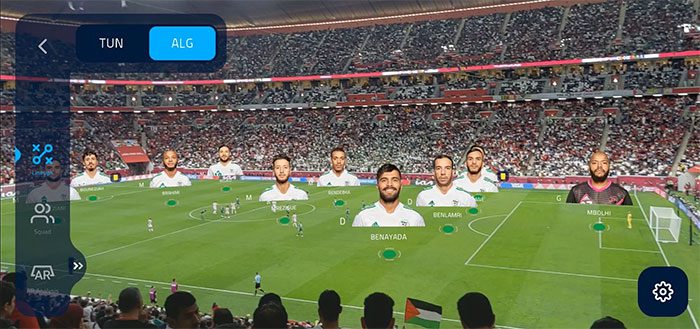It can be confidently stated that the 2022 World Cup is one of the largest global sporting events that has implemented many of the latest technologies available today. From advanced climate control systems that cool the stadiums to semi-automated offside technology and highly sensitive sensor chips embedded within the official match ball, these innovations have brought unprecedented experiences to players from 32 countries competing in Qatar.
Notably, FIFA has also adopted some of the latest technologies specifically for the audience, enhancing the viewing experience with the launch of a mobile application called FIFA+.
Implementation of Augmented Reality Technology
Watching the World Cup live at the stadium differs significantly from viewing it on TV. Besides the absence of commentary, spectators may struggle to clearly see the players or even miss some notable moments on the field due to a few seconds of distraction.

The FIFA+ app interface, featuring AR technology that allows viewers to engage more deeply with the match.
However, with the support of the FIFA+ app, on-site spectators can follow the players in greater detail, akin to watching on a TV screen. These statistics are not just displayed plainly on the phone screen; instead, they are showcased using Augmented Reality (AR) technology, enabling users to visually and engagingly follow slow-motion replays via the VAR system or view the match from various camera angles.
Known as the FIFA+ Stadium Experience, this feature integrated into the FIFA+ app is exclusively available for fans attending live matches at the stadium.
Using this feature is quite simple; users just need to open the FIFA+ app on their phones and point the camera towards the playing field. A secondary interface will appear, allowing them to tap on any player visible on their phone screen to access information such as name, jersey number, and real-time statistics including speed, distance traveled, and heat maps for each player.
Additionally, the VAR replay feature is particularly beneficial for on-site spectators, especially when they are unclear about the referee’s decisions.
A clip showing a fan using the AR technology of the FIFA+ app in the stadium. (Source: ESPN).
For example, in the controversial situation during the match between Japan and Spain in the group stage of the 2022 World Cup, the referee initially disallowed a goal but reversed the decision after VAR showed part of the ball was still in play. Having the option to view VAR replays on their phones can help fans present understand the referee’s decisions in certain situations, especially if they missed the slow-motion replays on the stadium’s big screen.
Moreover, users can review slow-motion clips or rewind missed plays… Additionally, highlighted information, live statistics, and articles about the World Cup are quickly updated within the app.
Besides FIFA+, the 2022 World Cup also features the FIFA Player app, which provides detailed data on each player’s performance after every match. This technology is being utilized for the first time at the World Cup.
Another technology called Feelix Palm was also used during the FIFA World Cup in Qatar. By utilizing electric pulses, this technology operates through haptic feedback devices in the palm, transmitting messages similar to Braille to visually impaired individuals, allowing them to easily experience the matches at the World Cup.




















































